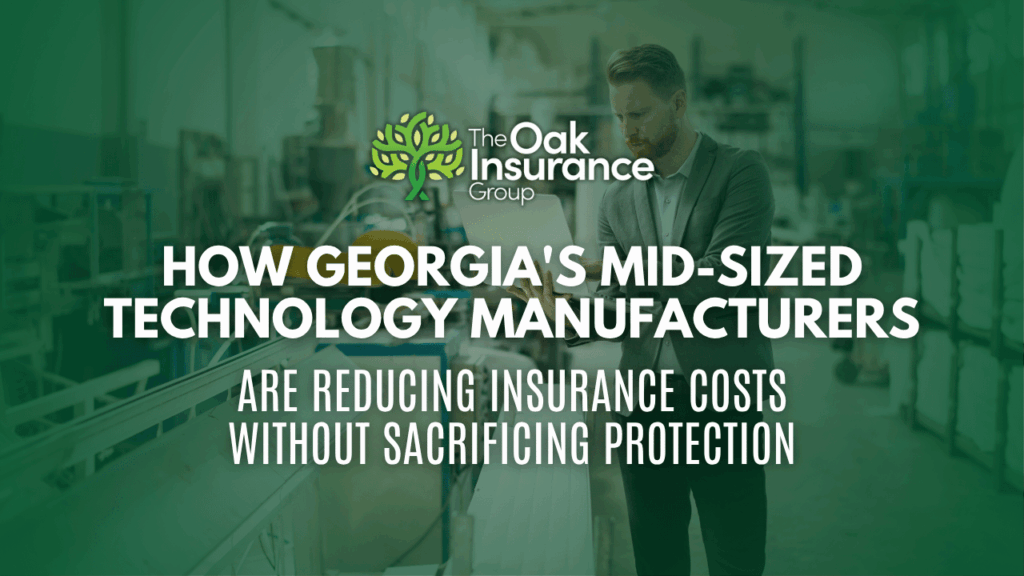
What if you could cut your insurance premiums by a quarter while actually strengthening your coverage? Georgia’s mid-sized technology manufacturers are doing just that—transforming insurance from a necessary expense into a strategic advantage. Manus AI, with over a decade of advising growing manufacturers, reveals five proven approaches that can trim your premiums by 10–25% and leave your operation more resilient than ever.
1. Drive Down Premiums with Data-Driven Risk Control
Key insight: Tackling your biggest exposures first delivers the largest savings.
- Full-spectrum risk audits. Map out fire, theft, cyber, supply-chain and regulatory risks through facility inspections and historical-loss analysis.
- Quantify impact. Use predictive analytics or Monte Carlo simulations to rank vulnerabilities by potential cost.
- Smart sensors and AI dashboards. Install vibration monitors, environmental sensors and real-time analytics to spot issues before they escalate into claims.
- Employee-powered prevention. Train every team member to spot hazards—and reward those who report near-misses.
- Rigorous documentation. Keep inspection reports, training logs and drill records at your fingertips to earn insurer confidence and negotiate lower rates.
2. Cut Workers’ Comp Costs by Fostering a True Safety Culture
Key insight: When safety becomes a core value, injury rates—and premiums—plummet.
- Leadership in the trenches. Have executives join toolbox talks and share safety successes company-wide.
- Open reporting. Offer anonymous hotlines for near-misses, and recognize employees who flag hazards.
- High-tech training. Use VR simulations for emergency drills and wearables that alert teams to dangerous conditions.
- Metrics beyond the basics. Track near-miss frequency, training completion and employee safety surveys, not just recordables.
- Celebrate milestones. Publicize injury-free streaks and reward the teams that make them happen.
3. Bundle and Customize Policies for 10–20% Savings
Key insight: A single, well-structured program outperforms multiple standalone policies.
- Combine coverages. Package general liability, property, cyber and workers’ comp with one carrier to unlock volume discounts.
- Tailor to your risks. Work with a specialist broker to add modules—contingent business interruption, product recall or regulatory fines—only where you need them.
- Synchronize renewals. Align all policies to a common renewal date so you negotiate from a position of strength.
- Raise retentions. Opt for higher deductibles or self-insured retentions if your balance sheet can support it, trading a bit more risk for lower premiums.
- Tap captives. Join a group or cell captive to pool risks, share profits and access specialty coverages off-limits to the open market.
4. Leverage Advanced Technology for Better Rates
Key insight: Insurers reward manufacturers who instrument and analyze their operations in real time.
- IoT monitoring: Outfit critical assets with sensors that flag anomalies, preventing breakdowns before they happen.
- Predictive maintenance: Use machine learning to schedule upkeep just in time, minimizing downtime and damage claims.
- Supply-chain visibility: Implement platforms that track supplier performance and alert you to disruptions—lowering your business-interruption exposure.
- Robust cybersecurity. Deploy threat detection, incident response and recovery tools that earn you cyber-premium discounts.
- Digital compliance. Automate audit trails and documentation so renewals become a showcase of your controls, not a scramble for missing files.
5. Gain Premium Credits Through Proactive Compliance
Key insight: Exceeding regulatory requirements translates into a stronger risk profile—and lower rates.
- Regulation mapping. Create a digital matrix of OSHA, EPA, FDA and Georgia’s new data-protection laws so nothing slips through the cracks.
- Compliance-by-design. Embed regulatory checks into product and process development—making audits a formality, not a headache.
- Automated record-keeping. Use compliance software to capture, organize and retrieve documentation at the touch of a button.
- Ongoing education. Deliver role-based training on evolving standards so your team stays ahead of audit triggers.
- Third-party validation. Pursue ISO, quality-management or cybersecurity certifications to showcase your rigor and earn insurer goodwill.
Real-World Results
- Savannah Electronics Manufacturer: Diversified suppliers and deployed IoT monitoring → 22% premium reduction and $800K in avoided downtime.
- Columbus Medical Device Maker: Adopted design-driven compliance and digital records → 14% premium cut plus quicker FDA approvals and stronger customer contracts.
- Atlanta Tech Startup: Joined a group captive with strict risk standards → 25% lower insurance costs on coverage tailored for emerging-tech exposures.
Your Next Move
You now have a proven, five-step framework to lower your insurance costs by up to 25% while strengthening your coverage. Ready to see exactly what you could save? Get a quote today and turn risk management into your next competitive advantage.

